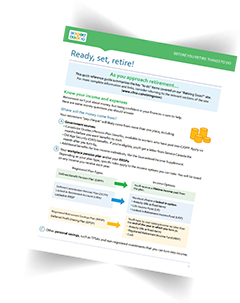3 simple ways to draft powerful messages clients want to hear
Looking for a better way to connect with clients? Promoting financial literacy might be easier than you think. Marketing efforts in the insurance industry are rapidly becoming more consumer driven. Clients are telling us what information they want and how they want to receive it. It’s a culture of clarity and one that’s quickly gaining momentum.
But in the words of renowned playwright George Bernard Shaw, “the greatest problem with communication is the illusion that it’s taken place.” Don’t assume clients understand and appreciate what you’re saying. Here are three simple ways to make sure they do:
 1. Talk about lifestyle options, not debt shaming. According to a recent article by Carleton University Economics Professor Frances Wooley, promoting financial literacy by telling Canadians to start with a budget is about as effective as declaring National Fat Shaming Month and advising them to start with a diet. It’s better to talk about lifestyle choices and how there could be several small changes that could lead to long-term financial freedom.
1. Talk about lifestyle options, not debt shaming. According to a recent article by Carleton University Economics Professor Frances Wooley, promoting financial literacy by telling Canadians to start with a budget is about as effective as declaring National Fat Shaming Month and advising them to start with a diet. It’s better to talk about lifestyle choices and how there could be several small changes that could lead to long-term financial freedom.
Wise spending habits and sound investment skills are rooted in basic math principles. Many consumers don’t exercise the self-discipline they need to be fiscally responsible. Some financial experts say exposing people to more rigorous and regular mathematics study from a much earlier age could make the difference in getting more people to embrace the habit of thinking strategically about their finances1. By offering clients the tools to make better financial decisions, advisors can show clients how they can control their own financial direction. Check out the Canadian Life and Health Insurance Association’s retiring soon page and consider including its content in client messaging. It features a quick reference summary document filled with financial tips, recommendations and resources.
Did you know that according to a Credit Counselling Society (CCS) survey, of those households generating more than $100,000, 72% claim to be financially literate but don’t follow a budget or spending plan?2 The CCS suggests while many people believe they’re financially literate, their actions tell a different story. More needs to be done to bridge the gap and change behaviour.
2. Use plain language. How actions can have a huge impact on financial stability is an important part of any conversation between the advisor and the client. But the language of that conversation is also enormously significant. How well do clients really understand the information they receive or hear from their advisor? Is the advisor making a meaningful connection? Do clients know exactly what they’ve purchased and how it suits their needs?
Insurance has been typically known as a complex subject for consumers, but it doesn’t have to be. Capitalize on the greater industry trend toward transparency on fees, incentives, and conflicts of interest and extend it to improving and simplifying client communications. Resist the temptation to use clichés, jargon and technical terms. Try presenting information in short, simple sentences that demonstrate a logical order with the main idea first. Be precise when explaining ideas and products.
Descriptive headings and subheadings can be helpful to focus on the key ideas. When drafting communications, ask three questions: why should the audience care, how do they benefit and what do they need to do?
Speaking to clients in plain language doesn’t mean messages have to be over-simplified or condescending. Choose vocabulary that’s straightforward and avoids ambiguity. It’s a good idea to write in active voice not passive. Sentence structure that’s direct and logical helps clients clearly see what the action is and how they benefit. For example, look at the complexity of this sentence:
The prescribed fee schedule is intended to assist investors in understanding the costs and expenses that a shareholder in the fund will bear directly or indirectly.
Here’s a simplified wording that gets directly to the point:
This table makes it easier to see what fees and expenses you may pay if you buy and hold shares of the fund.
3. Tell a story. It’s a creative strategy that really works. Consumers want to feel inspired and motivated. Take them on a journey that engages their mind and emotions. A good story will capture an audience and keep their attention to the end. Instead of going first to facts and figures, open with the story. A particularly compelling technique involves the hero journey persona. The writer tells the tale of a difficult journey that sets the main character on a quest to what can be seen as an unknown destination where they may encounter challenges or difficulty. The main character returns home with a reward or wisdom that can help their family or community. This genre is great for taking an audience on a learning adventure, addresses the value of adversity and most importantly, offers a new insight.
In this digital age, our ability to offer content in the most clear and appealing format will be the key to a successful relationship between clients and the insurance company they choose. They demand and expect to hear from advisors who can deliver advice and information that makes sense. It’s possible to change people’s attitudes about the value of financial literacy and create a lasting connection with clients by harnessing the power of plain language.
1 Cole, Shawn.,Paulson, Anna.,Shastry, Gauri Kartini. High School Curriculum and Financial Outcomes. Harvard Business School. 2015.
2 CCS Financial Literacy survey, 2015.